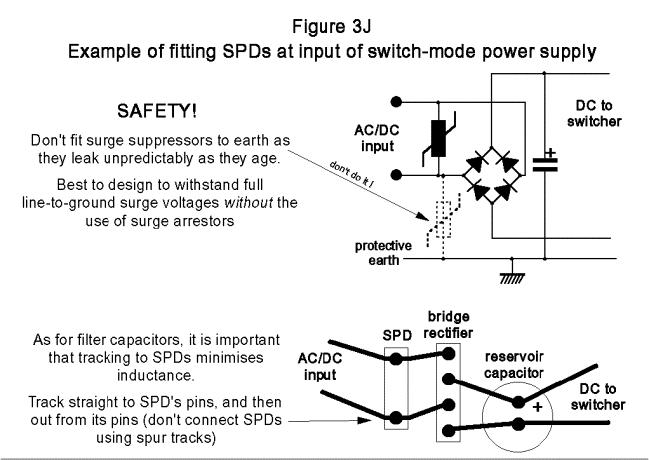
- •Filter design, selection, and installation
- •How filters work
- •The advantages of soft ferrites
- •Inductance variation with current
- •Determining filter specifications
- •Earth leakage currents, and safety
- •Issues of frequency and/or sensitivity of wanted signals
- •Filter earthing
- •The synergy of filters and shielding
- •Filter construction, mounting, and cabling
- •Surge protection devices (SPDs)
- •Types of SPD
- •Are SPDs needed on data lines?
- •SPDs and data integrity
- •Ratings of SPDs
- •Fusing of SPDs
- •Assembly of SPDs
- •The problems of earth lift
- •Further reading

3.14.6Assembly of SPDs
SPDs, like filters, can be used to suppress unwanted DM or CM signals. In the jargon common to the surge community, DM surges are usually called line-to-line (or symmetrical), and CM surges become line-to-ground (or asymmetrical).
SPDs are always used in shunt mode, to “short out” the surge voltages. Also like filters, SPDs only function as expected when assembled correctly. One of the most important issues is to avoid lead inductance.
When surge currents flow in lead inductance they create voltages which increase the “let-through” voltage. As is shown in Figure 3J, it is best to track (or wire) the incoming power (or signal) directly to the terminals of its SPD, and then connect the protected circuitry to the SPD terminals too.
Figure 3J also shows that the use of SPDs from phase to earth is strongly discouraged, if not prohibited, for portable or pluggable equipment because of the unpredictable earth leakages of SPDs as they wear out, and the resulting safety problems. So it is best to use other means to deal with line-to-earth (common-mode) surges.
However, SPDs between supply phases and ground may be acceptable for permanently-wired equipment, especially if it has duplicated protective earth conductors, so that if one is faulty the other prevents electric shock from any SPD earth leakage. SPDs are commonly connected phase to ground in building installations, to help protect the equipment in the building from lightning surges (e.g. see BS6651 Appendix C), but in such instances the building’s earth structure (its common bonding network) should have a high degree of redundancy and not depend upon any single conductor for safety.
Design techniques for EMC – Part 3 |
Cherry Clough Consultants June 99 |
Page 17 of 19 |
